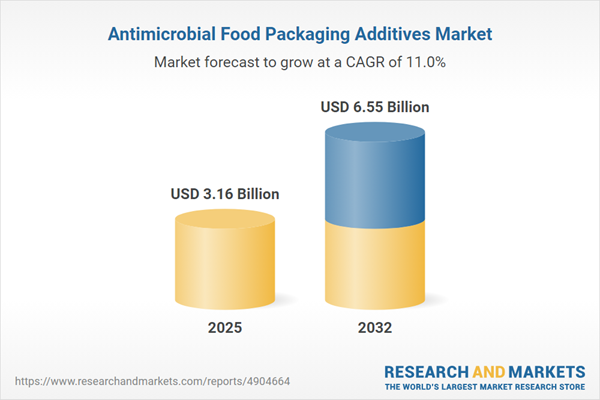Speak directly to the analyst to clarify any post sales queries you may have.
The antimicrobial food packaging additives market is adapting to regulatory intricacies, shifting supply chain models, and mounting sustainability expectations. Senior decision-makers are steering proactive strategies that enhance transparency, balance regional supply risks, and foster the adoption of compliant and innovative packaging solutions.
Market Snapshot: Antimicrobial Food Packaging Additives Market Overview
This sector is registering robust growth, driven by rising food safety standards and increasing requirements for prolonged shelf life and distinctive product presentation. Market direction is shaped by evolving compliance frameworks and fast-track innovation cycles as companies aim to fulfill customer and regulatory demands for safer, more traceable, and eco-conscious packaging. Leading organizations leverage advances in antimicrobial food packaging additives to unite shared objectives spanning compliance and sustainability. A rapidly changing regulatory climate is fostering stronger supplier relationships and promoting agile approaches to distribution and risk management, making a multi-regional strategy necessary for market success.
Scope & Segmentation of the Antimicrobial Food Packaging Additives Market
- Packaging Materials: Biopolymers like cellulose, polylactic acid, polyhydroxyalkanoate, and starch offer sustainable alternatives, while glass and metals such as aluminum and tin support high-barrier needs for sensitive goods. Paper and board are favored by companies targeting eco-centric branding, and flexible plastics (polyethylene, PET, polypropylene, PVC) meet the needs of varied product categories in food and beverage.
- Additive Types: Natural solutions such as bacteriocins, essential oils, and plant-based extracts enable alignment with clean-label trends and enhance traceability, whereas synthetic additives are preferred for their broader protection across differing regulatory environments.
- Applications: Segments utilizing these solutions include bakery, confectionery, dairy, produce, meats, poultry, seafood, and ready-to-eat foods, each with its own handling and regulatory requirements.
- Form Factors: Additives are deployable via extruded films, multilayer laminates, labels, sachets, pouches, and trays, enabling both operational efficiency and adherence to safety goals.
- End Use Industry: Adoption rates are rising in food service, institutional procurement, and retail as organizations seek to standardize quality protocols and compliance throughout intricate global supply chains.
- Distribution Channel: Robust distribution balances established B2B partnerships with digital commerce networks so suppliers can respond quickly to market changes or disruption.
- Regional Coverage: Leadership strategies are regionally tailored to address regulatory nuances and buyer expectations in the Americas, Europe, Asia-Pacific, and the Middle East & Africa, illustrating the value of localized compliance and supply models.
Key Takeaways for Senior Decision-Makers
- Integrating plant-derived and enzymatic additives supports greater supply chain visibility, directly addressing evolving regulatory and client criteria related to transparency and product origins.
- Adoption of digital documentation processes enhances audit efficiency and builds partner trust in safety management practices throughout the B2B ecosystem.
- Implementing advanced multilayer and active packaging technologies positions businesses to navigate changing quality standards and operational risks across regions.
- Continuous material innovation, especially with biopolymers, enables packaging approaches to remain synchronized with sustainability goals and responsible sourcing initiatives.
- Supplier collaboration accelerates uptake of new additive technologies, allowing organizations to anticipate and rapidly adjust to changing regulatory requirements.
- Expanding the diversity of supply partners bolsters operational continuity, providing resilience against disruptions such as regional logistics or market volatility.
Tariff Impact: Strategic Response to US 2025 Tariff Changes
The recent introduction of US tariffs on antimicrobial food packaging imports from Asia has encouraged businesses to strengthen domestic supplier ties and elevate regional production. This move enables the sourcing of more traceable and plant-based additives, while supporting rapid adaptation to North American labeling norms. Companies are reassessing sourcing and regulatory compliance frameworks to remain flexible as wider trade requirements continue to evolve and impact market access.
Methodology & Data Sources
The report draws from direct interviews with leading suppliers and industry experts, targeted surveys, regulatory analysis, and proprietary case studies from major players in the sector. Intellectual property reviews and ongoing market monitoring support a comprehensive view of key developments.
Why This Report Matters
- Supports leadership teams in developing forward-looking approaches to technology integration and navigating compliance in antimicrobial packaging.
- Enables improved supply chain resilience, equipping businesses to anticipate and respond to changing international compliance protocols and market disruptions.
- Ensures decision-makers are prepared to capitalize on growth segments and shifting regulatory dynamics with timely strategic insights.
Conclusion
Positioning operational strategies in line with regulatory and sustainability priorities enables organizations to secure market stability and drive long-term results. Continued partnership and innovation are essential to maintaining competitive advantage and business continuity in this evolving sector.
Additional Product Information:
- Purchase of this report includes 1 year online access with quarterly updates.
- This report can be updated on request. Please contact our Customer Experience team using the Ask a Question widget on our website.
Table of Contents
3. Executive Summary
4. Market Overview
7. Cumulative Impact of Artificial Intelligence 2025
Companies Mentioned
The companies profiled in this Antimicrobial Food Packaging Additives market report include:- Microban International, Ltd.
- BASF SE
- The Dow Chemical Company
- Mondi plc
- Dunmore Corporation
- BioCote Limited
- Oplon Pure Science Ltd.
- Avient Corporation
- Camlin Fine Sciences Ltd.
- Intralytix, Inc.
- Kastus Technologies
- Takex Labo Co., Ltd.
- Americhem, Inc.
- Phoenix Plastics
- Addmaster (UK) Ltd.
Table Information
| Report Attribute | Details |
|---|---|
| No. of Pages | 185 |
| Published | October 2025 |
| Forecast Period | 2025 - 2032 |
| Estimated Market Value ( USD | $ 3.16 Billion |
| Forecasted Market Value ( USD | $ 6.55 Billion |
| Compound Annual Growth Rate | 11.0% |
| Regions Covered | Global |
| No. of Companies Mentioned | 16 |









